LAW001-2 Land Law: An Analysis of Mortgagor and Mortgagee Rights
VerifiedAdded on 2023/06/15
|13
|3799
|307
Essay
AI Summary
This essay examines the evolving legal landscape surrounding the rights of mortgagors and mortgagees, focusing on possession of mortgaged property. It argues that the mortgagor's position has strengthened in contemporary law, particularly following the Cheltenham and Gloucester Building Society v. Norgan case. The essay analyzes the impact of the Administration of Justice Act 1970 and 1973, which granted courts discretion in possession matters, and how Norgan redefined the concept of a 'reasonable period' for repayment. It considers arguments for and against the current balance of rights, concluding that while the Norgan decision aimed to balance interests, courts must carefully assess potential risks to mortgagees' financial interests when extending repayment periods. The document is available on Desklib, a platform offering study tools and resources for students.

Running head: LAND LAW
Land Law
Name of student:
Name of the university:
Author note:
Land Law
Name of student:
Name of the university:
Author note:
Paraphrase This Document
Need a fresh take? Get an instant paraphrase of this document with our AI Paraphraser
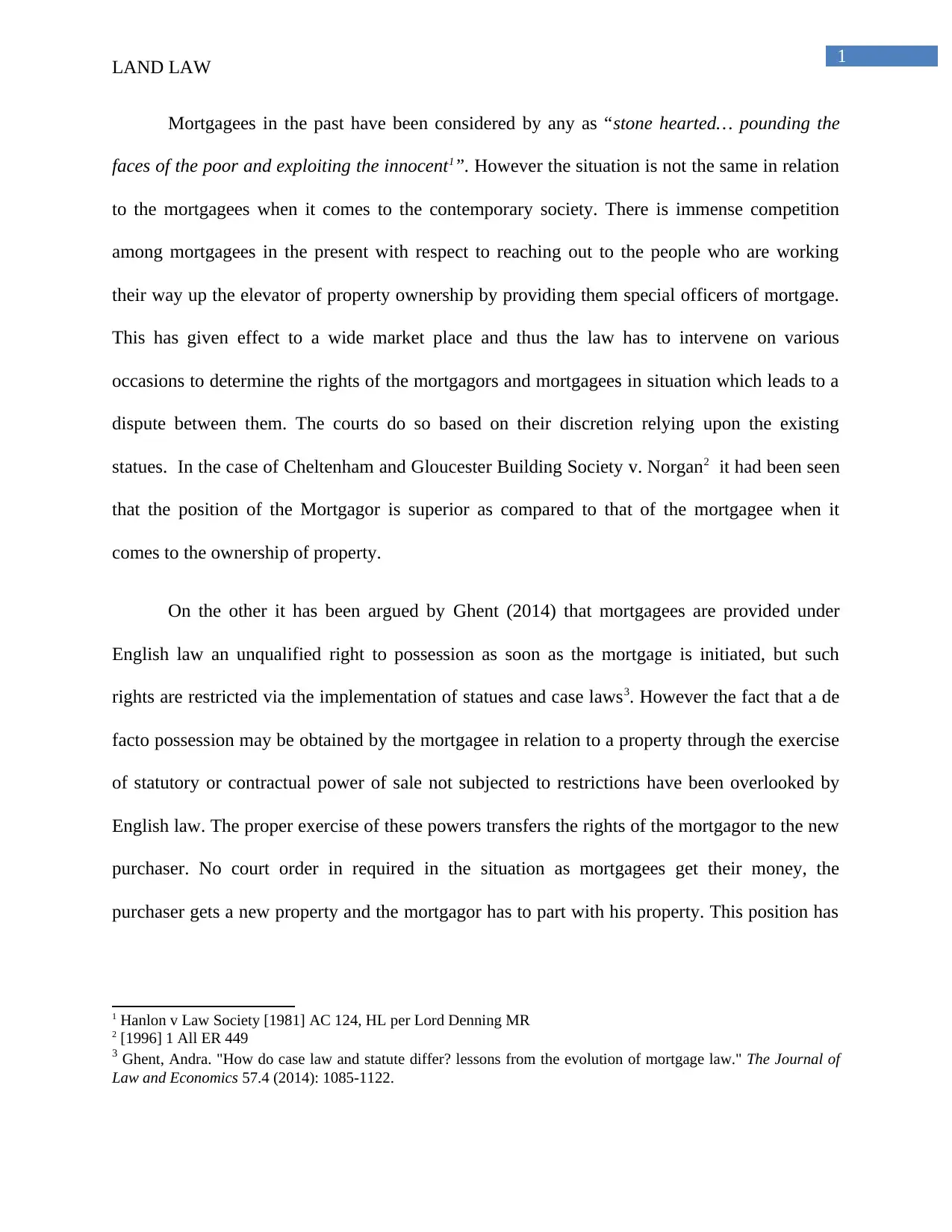
1
LAND LAW
Mortgagees in the past have been considered by any as “stone hearted… pounding the
faces of the poor and exploiting the innocent1”. However the situation is not the same in relation
to the mortgagees when it comes to the contemporary society. There is immense competition
among mortgagees in the present with respect to reaching out to the people who are working
their way up the elevator of property ownership by providing them special officers of mortgage.
This has given effect to a wide market place and thus the law has to intervene on various
occasions to determine the rights of the mortgagors and mortgagees in situation which leads to a
dispute between them. The courts do so based on their discretion relying upon the existing
statues. In the case of Cheltenham and Gloucester Building Society v. Norgan2 it had been seen
that the position of the Mortgagor is superior as compared to that of the mortgagee when it
comes to the ownership of property.
On the other it has been argued by Ghent (2014) that mortgagees are provided under
English law an unqualified right to possession as soon as the mortgage is initiated, but such
rights are restricted via the implementation of statues and case laws3. However the fact that a de
facto possession may be obtained by the mortgagee in relation to a property through the exercise
of statutory or contractual power of sale not subjected to restrictions have been overlooked by
English law. The proper exercise of these powers transfers the rights of the mortgagor to the new
purchaser. No court order in required in the situation as mortgagees get their money, the
purchaser gets a new property and the mortgagor has to part with his property. This position has
1 Hanlon v Law Society [1981] AC 124, HL per Lord Denning MR
2 [1996] 1 All ER 449
3 Ghent, Andra. "How do case law and statute differ? lessons from the evolution of mortgage law." The Journal of
Law and Economics 57.4 (2014): 1085-1122.
LAND LAW
Mortgagees in the past have been considered by any as “stone hearted… pounding the
faces of the poor and exploiting the innocent1”. However the situation is not the same in relation
to the mortgagees when it comes to the contemporary society. There is immense competition
among mortgagees in the present with respect to reaching out to the people who are working
their way up the elevator of property ownership by providing them special officers of mortgage.
This has given effect to a wide market place and thus the law has to intervene on various
occasions to determine the rights of the mortgagors and mortgagees in situation which leads to a
dispute between them. The courts do so based on their discretion relying upon the existing
statues. In the case of Cheltenham and Gloucester Building Society v. Norgan2 it had been seen
that the position of the Mortgagor is superior as compared to that of the mortgagee when it
comes to the ownership of property.
On the other it has been argued by Ghent (2014) that mortgagees are provided under
English law an unqualified right to possession as soon as the mortgage is initiated, but such
rights are restricted via the implementation of statues and case laws3. However the fact that a de
facto possession may be obtained by the mortgagee in relation to a property through the exercise
of statutory or contractual power of sale not subjected to restrictions have been overlooked by
English law. The proper exercise of these powers transfers the rights of the mortgagor to the new
purchaser. No court order in required in the situation as mortgagees get their money, the
purchaser gets a new property and the mortgagor has to part with his property. This position has
1 Hanlon v Law Society [1981] AC 124, HL per Lord Denning MR
2 [1996] 1 All ER 449
3 Ghent, Andra. "How do case law and statute differ? lessons from the evolution of mortgage law." The Journal of
Law and Economics 57.4 (2014): 1085-1122.
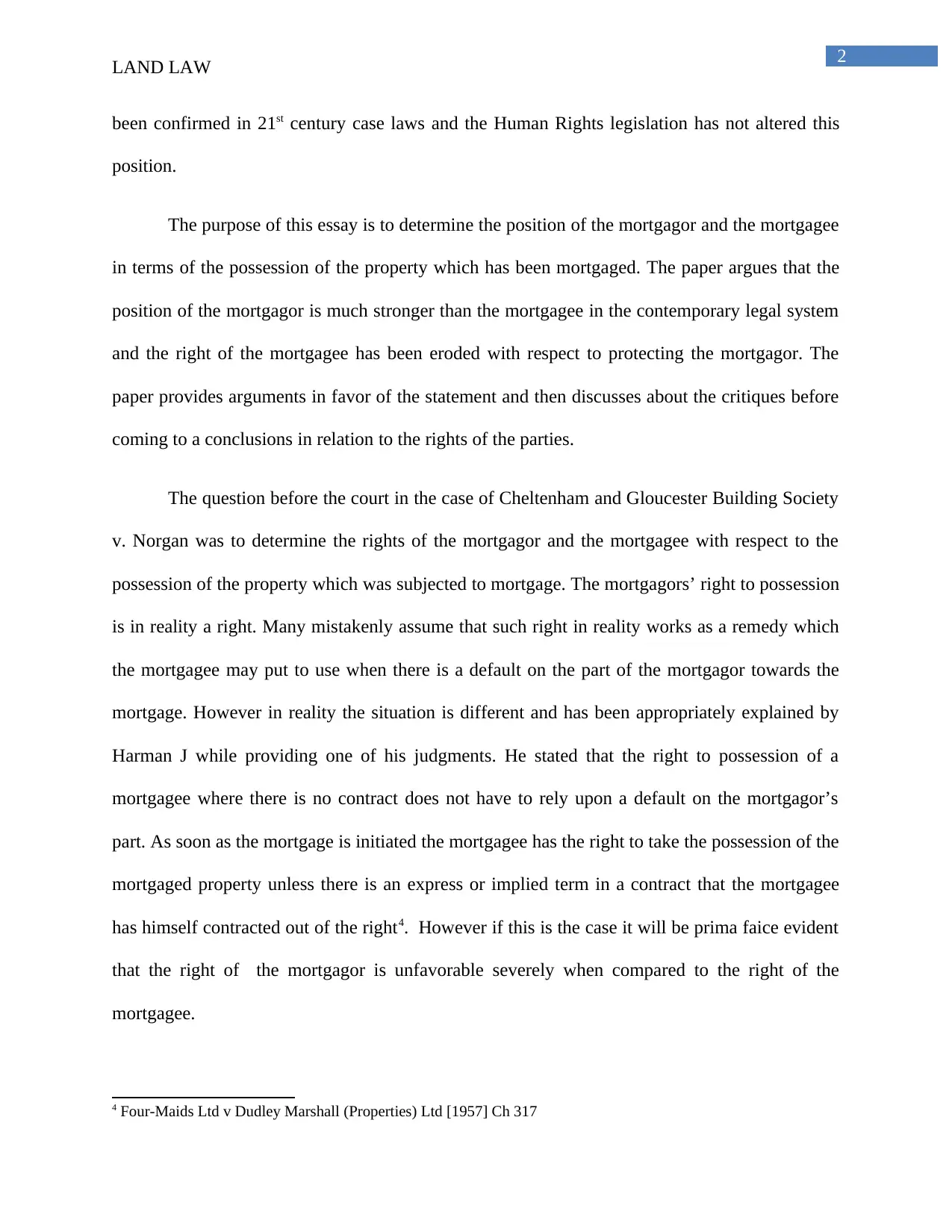
2
LAND LAW
been confirmed in 21st century case laws and the Human Rights legislation has not altered this
position.
The purpose of this essay is to determine the position of the mortgagor and the mortgagee
in terms of the possession of the property which has been mortgaged. The paper argues that the
position of the mortgagor is much stronger than the mortgagee in the contemporary legal system
and the right of the mortgagee has been eroded with respect to protecting the mortgagor. The
paper provides arguments in favor of the statement and then discusses about the critiques before
coming to a conclusions in relation to the rights of the parties.
The question before the court in the case of Cheltenham and Gloucester Building Society
v. Norgan was to determine the rights of the mortgagor and the mortgagee with respect to the
possession of the property which was subjected to mortgage. The mortgagors’ right to possession
is in reality a right. Many mistakenly assume that such right in reality works as a remedy which
the mortgagee may put to use when there is a default on the part of the mortgagor towards the
mortgage. However in reality the situation is different and has been appropriately explained by
Harman J while providing one of his judgments. He stated that the right to possession of a
mortgagee where there is no contract does not have to rely upon a default on the mortgagor’s
part. As soon as the mortgage is initiated the mortgagee has the right to take the possession of the
mortgaged property unless there is an express or implied term in a contract that the mortgagee
has himself contracted out of the right4. However if this is the case it will be prima faice evident
that the right of the mortgagor is unfavorable severely when compared to the right of the
mortgagee.
4 Four-Maids Ltd v Dudley Marshall (Properties) Ltd [1957] Ch 317
LAND LAW
been confirmed in 21st century case laws and the Human Rights legislation has not altered this
position.
The purpose of this essay is to determine the position of the mortgagor and the mortgagee
in terms of the possession of the property which has been mortgaged. The paper argues that the
position of the mortgagor is much stronger than the mortgagee in the contemporary legal system
and the right of the mortgagee has been eroded with respect to protecting the mortgagor. The
paper provides arguments in favor of the statement and then discusses about the critiques before
coming to a conclusions in relation to the rights of the parties.
The question before the court in the case of Cheltenham and Gloucester Building Society
v. Norgan was to determine the rights of the mortgagor and the mortgagee with respect to the
possession of the property which was subjected to mortgage. The mortgagors’ right to possession
is in reality a right. Many mistakenly assume that such right in reality works as a remedy which
the mortgagee may put to use when there is a default on the part of the mortgagor towards the
mortgage. However in reality the situation is different and has been appropriately explained by
Harman J while providing one of his judgments. He stated that the right to possession of a
mortgagee where there is no contract does not have to rely upon a default on the mortgagor’s
part. As soon as the mortgage is initiated the mortgagee has the right to take the possession of the
mortgaged property unless there is an express or implied term in a contract that the mortgagee
has himself contracted out of the right4. However if this is the case it will be prima faice evident
that the right of the mortgagor is unfavorable severely when compared to the right of the
mortgagee.
4 Four-Maids Ltd v Dudley Marshall (Properties) Ltd [1957] Ch 317
⊘ This is a preview!⊘
Do you want full access?
Subscribe today to unlock all pages.

Trusted by 1+ million students worldwide
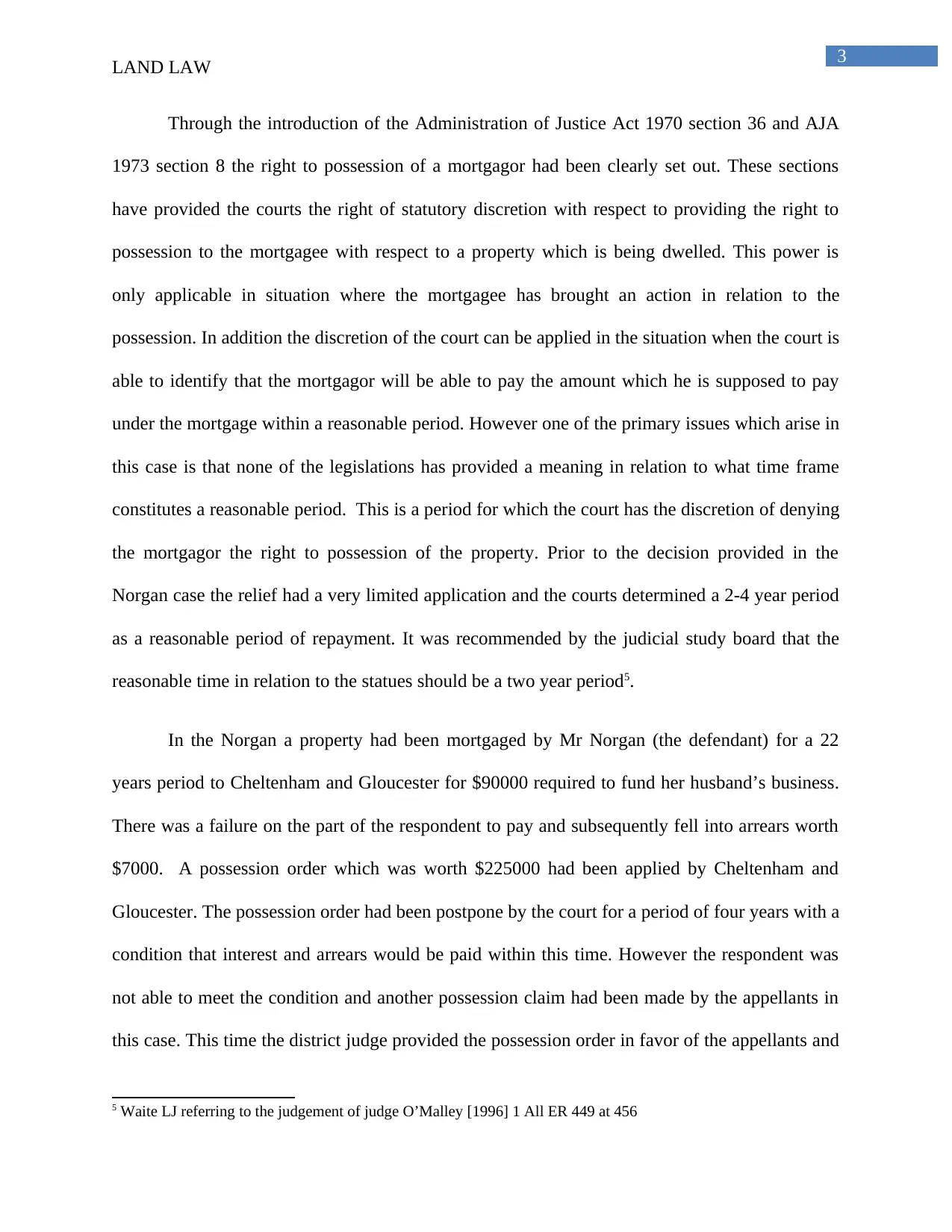
3
LAND LAW
Through the introduction of the Administration of Justice Act 1970 section 36 and AJA
1973 section 8 the right to possession of a mortgagor had been clearly set out. These sections
have provided the courts the right of statutory discretion with respect to providing the right to
possession to the mortgagee with respect to a property which is being dwelled. This power is
only applicable in situation where the mortgagee has brought an action in relation to the
possession. In addition the discretion of the court can be applied in the situation when the court is
able to identify that the mortgagor will be able to pay the amount which he is supposed to pay
under the mortgage within a reasonable period. However one of the primary issues which arise in
this case is that none of the legislations has provided a meaning in relation to what time frame
constitutes a reasonable period. This is a period for which the court has the discretion of denying
the mortgagor the right to possession of the property. Prior to the decision provided in the
Norgan case the relief had a very limited application and the courts determined a 2-4 year period
as a reasonable period of repayment. It was recommended by the judicial study board that the
reasonable time in relation to the statues should be a two year period5.
In the Norgan a property had been mortgaged by Mr Norgan (the defendant) for a 22
years period to Cheltenham and Gloucester for $90000 required to fund her husband’s business.
There was a failure on the part of the respondent to pay and subsequently fell into arrears worth
$7000. A possession order which was worth $225000 had been applied by Cheltenham and
Gloucester. The possession order had been postpone by the court for a period of four years with a
condition that interest and arrears would be paid within this time. However the respondent was
not able to meet the condition and another possession claim had been made by the appellants in
this case. This time the district judge provided the possession order in favor of the appellants and
5 Waite LJ referring to the judgement of judge O’Malley [1996] 1 All ER 449 at 456
LAND LAW
Through the introduction of the Administration of Justice Act 1970 section 36 and AJA
1973 section 8 the right to possession of a mortgagor had been clearly set out. These sections
have provided the courts the right of statutory discretion with respect to providing the right to
possession to the mortgagee with respect to a property which is being dwelled. This power is
only applicable in situation where the mortgagee has brought an action in relation to the
possession. In addition the discretion of the court can be applied in the situation when the court is
able to identify that the mortgagor will be able to pay the amount which he is supposed to pay
under the mortgage within a reasonable period. However one of the primary issues which arise in
this case is that none of the legislations has provided a meaning in relation to what time frame
constitutes a reasonable period. This is a period for which the court has the discretion of denying
the mortgagor the right to possession of the property. Prior to the decision provided in the
Norgan case the relief had a very limited application and the courts determined a 2-4 year period
as a reasonable period of repayment. It was recommended by the judicial study board that the
reasonable time in relation to the statues should be a two year period5.
In the Norgan a property had been mortgaged by Mr Norgan (the defendant) for a 22
years period to Cheltenham and Gloucester for $90000 required to fund her husband’s business.
There was a failure on the part of the respondent to pay and subsequently fell into arrears worth
$7000. A possession order which was worth $225000 had been applied by Cheltenham and
Gloucester. The possession order had been postpone by the court for a period of four years with a
condition that interest and arrears would be paid within this time. However the respondent was
not able to meet the condition and another possession claim had been made by the appellants in
this case. This time the district judge provided the possession order in favor of the appellants and
5 Waite LJ referring to the judgement of judge O’Malley [1996] 1 All ER 449 at 456
Paraphrase This Document
Need a fresh take? Get an instant paraphrase of this document with our AI Paraphraser
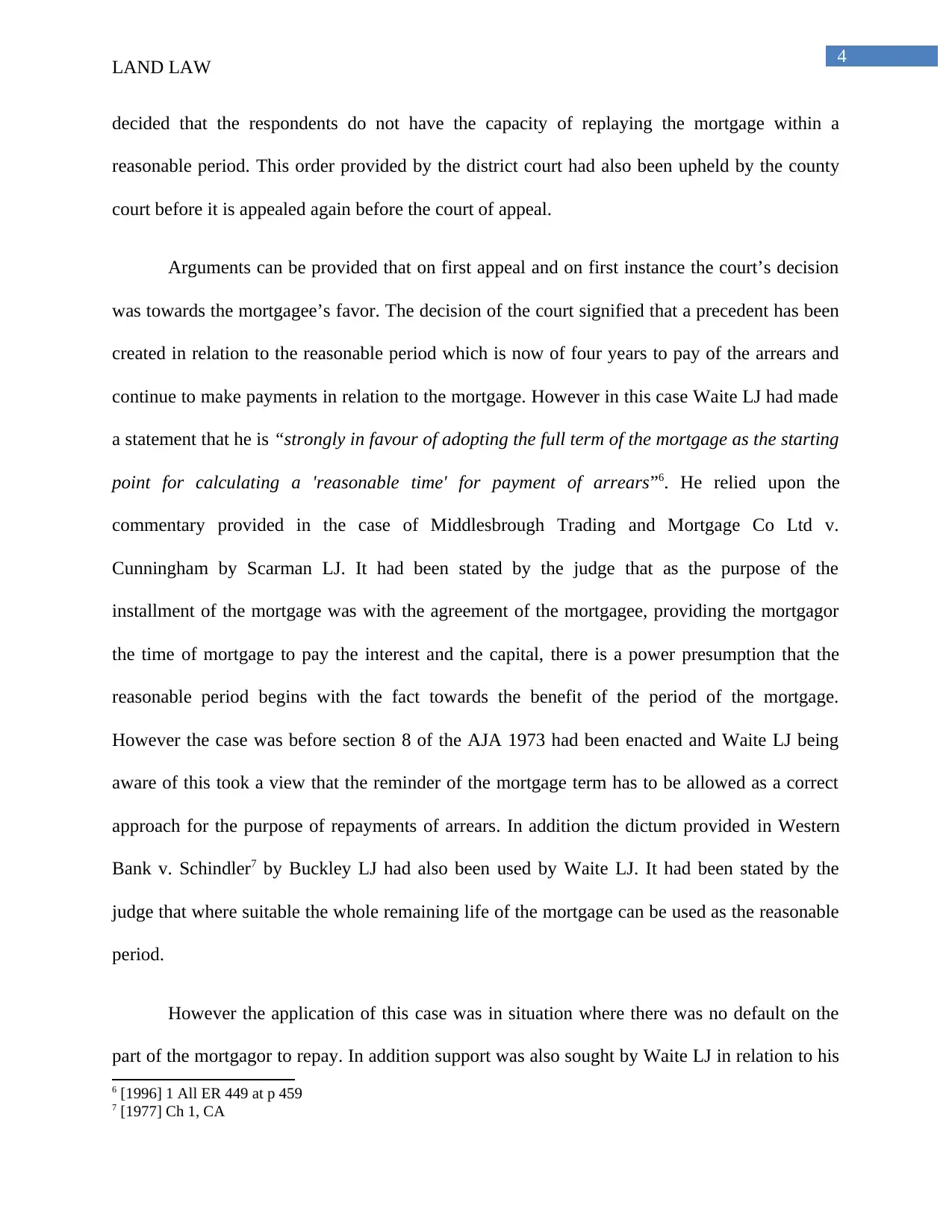
4
LAND LAW
decided that the respondents do not have the capacity of replaying the mortgage within a
reasonable period. This order provided by the district court had also been upheld by the county
court before it is appealed again before the court of appeal.
Arguments can be provided that on first appeal and on first instance the court’s decision
was towards the mortgagee’s favor. The decision of the court signified that a precedent has been
created in relation to the reasonable period which is now of four years to pay of the arrears and
continue to make payments in relation to the mortgage. However in this case Waite LJ had made
a statement that he is “strongly in favour of adopting the full term of the mortgage as the starting
point for calculating a 'reasonable time' for payment of arrears”6. He relied upon the
commentary provided in the case of Middlesbrough Trading and Mortgage Co Ltd v.
Cunningham by Scarman LJ. It had been stated by the judge that as the purpose of the
installment of the mortgage was with the agreement of the mortgagee, providing the mortgagor
the time of mortgage to pay the interest and the capital, there is a power presumption that the
reasonable period begins with the fact towards the benefit of the period of the mortgage.
However the case was before section 8 of the AJA 1973 had been enacted and Waite LJ being
aware of this took a view that the reminder of the mortgage term has to be allowed as a correct
approach for the purpose of repayments of arrears. In addition the dictum provided in Western
Bank v. Schindler7 by Buckley LJ had also been used by Waite LJ. It had been stated by the
judge that where suitable the whole remaining life of the mortgage can be used as the reasonable
period.
However the application of this case was in situation where there was no default on the
part of the mortgagor to repay. In addition support was also sought by Waite LJ in relation to his
6 [1996] 1 All ER 449 at p 459
7 [1977] Ch 1, CA
LAND LAW
decided that the respondents do not have the capacity of replaying the mortgage within a
reasonable period. This order provided by the district court had also been upheld by the county
court before it is appealed again before the court of appeal.
Arguments can be provided that on first appeal and on first instance the court’s decision
was towards the mortgagee’s favor. The decision of the court signified that a precedent has been
created in relation to the reasonable period which is now of four years to pay of the arrears and
continue to make payments in relation to the mortgage. However in this case Waite LJ had made
a statement that he is “strongly in favour of adopting the full term of the mortgage as the starting
point for calculating a 'reasonable time' for payment of arrears”6. He relied upon the
commentary provided in the case of Middlesbrough Trading and Mortgage Co Ltd v.
Cunningham by Scarman LJ. It had been stated by the judge that as the purpose of the
installment of the mortgage was with the agreement of the mortgagee, providing the mortgagor
the time of mortgage to pay the interest and the capital, there is a power presumption that the
reasonable period begins with the fact towards the benefit of the period of the mortgage.
However the case was before section 8 of the AJA 1973 had been enacted and Waite LJ being
aware of this took a view that the reminder of the mortgage term has to be allowed as a correct
approach for the purpose of repayments of arrears. In addition the dictum provided in Western
Bank v. Schindler7 by Buckley LJ had also been used by Waite LJ. It had been stated by the
judge that where suitable the whole remaining life of the mortgage can be used as the reasonable
period.
However the application of this case was in situation where there was no default on the
part of the mortgagor to repay. In addition support was also sought by Waite LJ in relation to his
6 [1996] 1 All ER 449 at p 459
7 [1977] Ch 1, CA
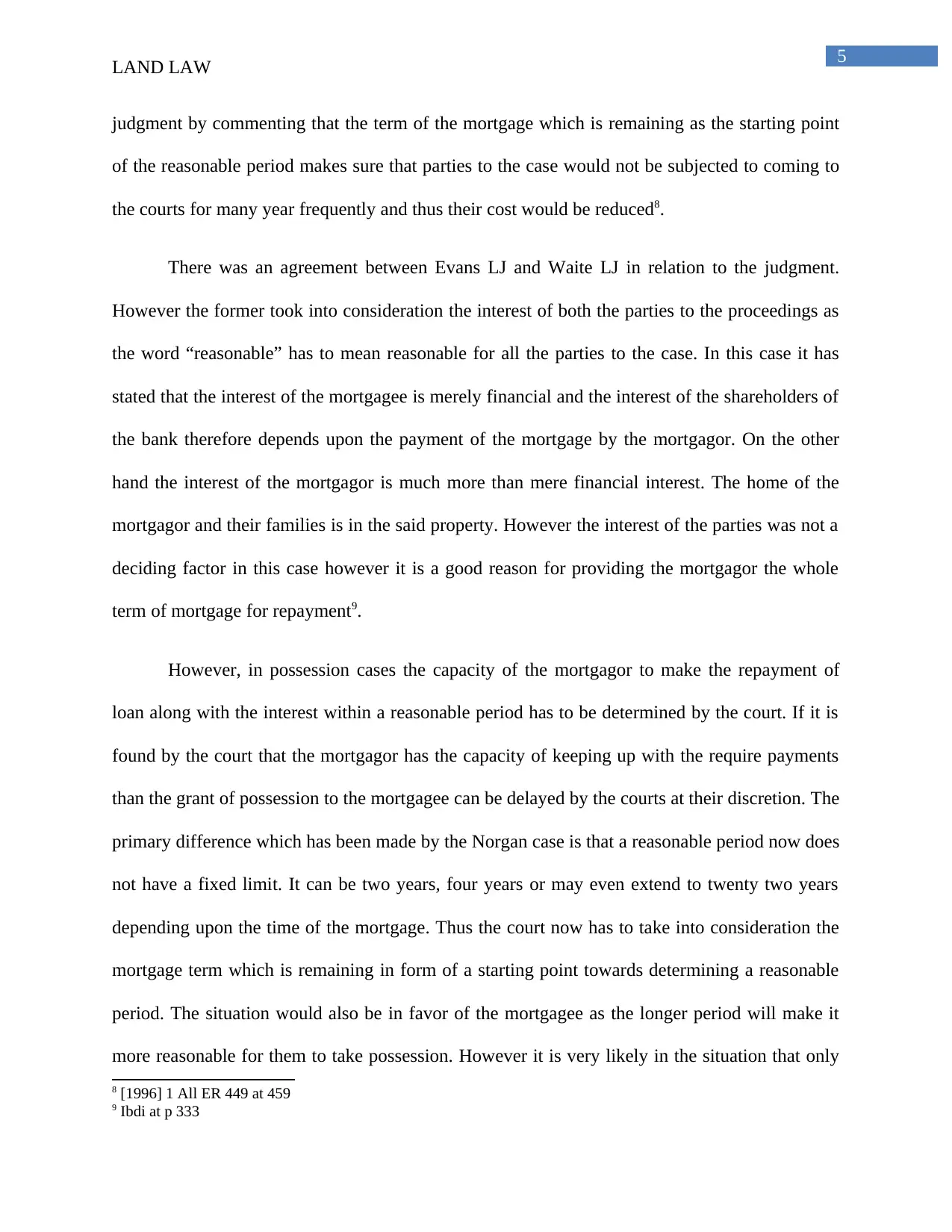
5
LAND LAW
judgment by commenting that the term of the mortgage which is remaining as the starting point
of the reasonable period makes sure that parties to the case would not be subjected to coming to
the courts for many year frequently and thus their cost would be reduced8.
There was an agreement between Evans LJ and Waite LJ in relation to the judgment.
However the former took into consideration the interest of both the parties to the proceedings as
the word “reasonable” has to mean reasonable for all the parties to the case. In this case it has
stated that the interest of the mortgagee is merely financial and the interest of the shareholders of
the bank therefore depends upon the payment of the mortgage by the mortgagor. On the other
hand the interest of the mortgagor is much more than mere financial interest. The home of the
mortgagor and their families is in the said property. However the interest of the parties was not a
deciding factor in this case however it is a good reason for providing the mortgagor the whole
term of mortgage for repayment9.
However, in possession cases the capacity of the mortgagor to make the repayment of
loan along with the interest within a reasonable period has to be determined by the court. If it is
found by the court that the mortgagor has the capacity of keeping up with the require payments
than the grant of possession to the mortgagee can be delayed by the courts at their discretion. The
primary difference which has been made by the Norgan case is that a reasonable period now does
not have a fixed limit. It can be two years, four years or may even extend to twenty two years
depending upon the time of the mortgage. Thus the court now has to take into consideration the
mortgage term which is remaining in form of a starting point towards determining a reasonable
period. The situation would also be in favor of the mortgagee as the longer period will make it
more reasonable for them to take possession. However it is very likely in the situation that only
8 [1996] 1 All ER 449 at 459
9 Ibdi at p 333
LAND LAW
judgment by commenting that the term of the mortgage which is remaining as the starting point
of the reasonable period makes sure that parties to the case would not be subjected to coming to
the courts for many year frequently and thus their cost would be reduced8.
There was an agreement between Evans LJ and Waite LJ in relation to the judgment.
However the former took into consideration the interest of both the parties to the proceedings as
the word “reasonable” has to mean reasonable for all the parties to the case. In this case it has
stated that the interest of the mortgagee is merely financial and the interest of the shareholders of
the bank therefore depends upon the payment of the mortgage by the mortgagor. On the other
hand the interest of the mortgagor is much more than mere financial interest. The home of the
mortgagor and their families is in the said property. However the interest of the parties was not a
deciding factor in this case however it is a good reason for providing the mortgagor the whole
term of mortgage for repayment9.
However, in possession cases the capacity of the mortgagor to make the repayment of
loan along with the interest within a reasonable period has to be determined by the court. If it is
found by the court that the mortgagor has the capacity of keeping up with the require payments
than the grant of possession to the mortgagee can be delayed by the courts at their discretion. The
primary difference which has been made by the Norgan case is that a reasonable period now does
not have a fixed limit. It can be two years, four years or may even extend to twenty two years
depending upon the time of the mortgage. Thus the court now has to take into consideration the
mortgage term which is remaining in form of a starting point towards determining a reasonable
period. The situation would also be in favor of the mortgagee as the longer period will make it
more reasonable for them to take possession. However it is very likely in the situation that only
8 [1996] 1 All ER 449 at 459
9 Ibdi at p 333
⊘ This is a preview!⊘
Do you want full access?
Subscribe today to unlock all pages.

Trusted by 1+ million students worldwide
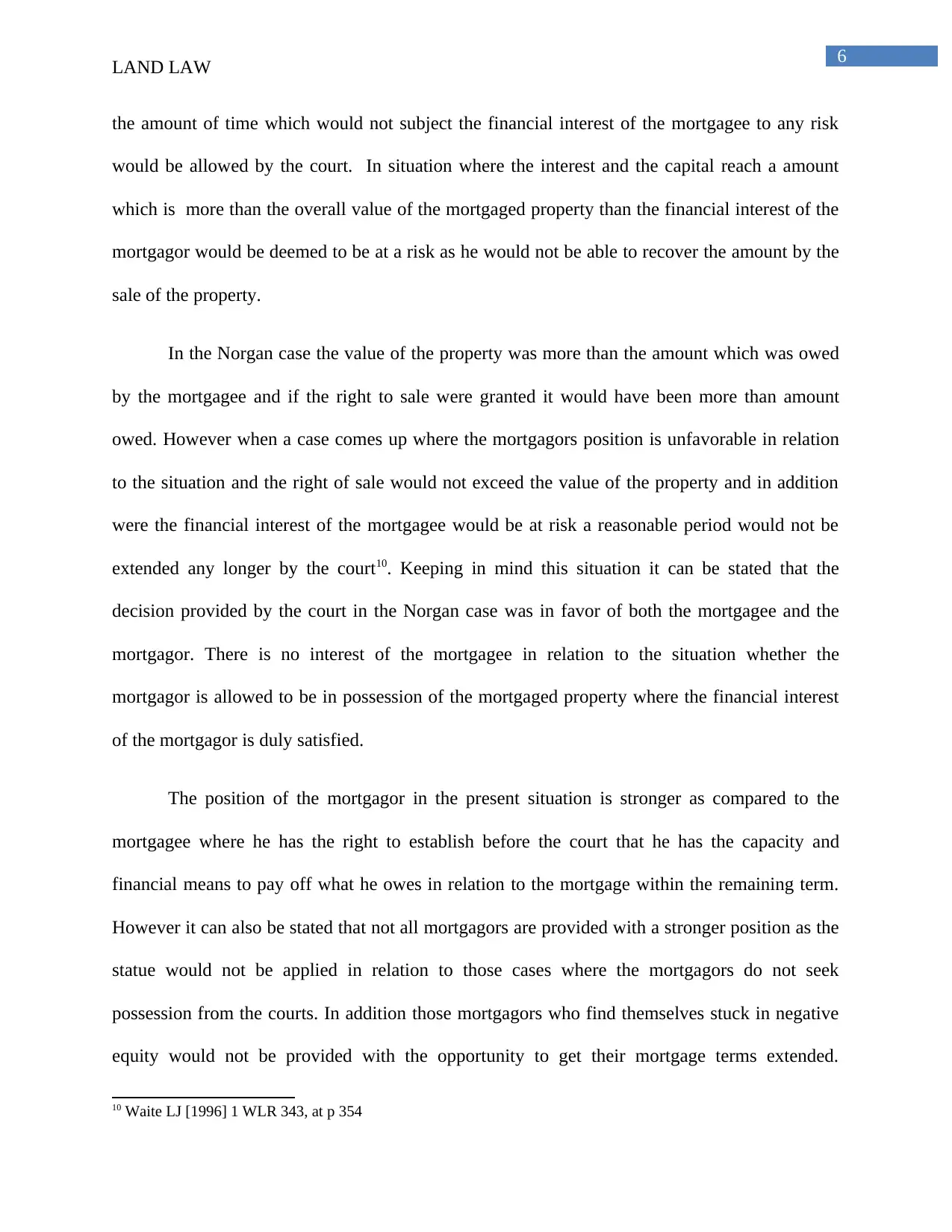
6
LAND LAW
the amount of time which would not subject the financial interest of the mortgagee to any risk
would be allowed by the court. In situation where the interest and the capital reach a amount
which is more than the overall value of the mortgaged property than the financial interest of the
mortgagor would be deemed to be at a risk as he would not be able to recover the amount by the
sale of the property.
In the Norgan case the value of the property was more than the amount which was owed
by the mortgagee and if the right to sale were granted it would have been more than amount
owed. However when a case comes up where the mortgagors position is unfavorable in relation
to the situation and the right of sale would not exceed the value of the property and in addition
were the financial interest of the mortgagee would be at risk a reasonable period would not be
extended any longer by the court10. Keeping in mind this situation it can be stated that the
decision provided by the court in the Norgan case was in favor of both the mortgagee and the
mortgagor. There is no interest of the mortgagee in relation to the situation whether the
mortgagor is allowed to be in possession of the mortgaged property where the financial interest
of the mortgagor is duly satisfied.
The position of the mortgagor in the present situation is stronger as compared to the
mortgagee where he has the right to establish before the court that he has the capacity and
financial means to pay off what he owes in relation to the mortgage within the remaining term.
However it can also be stated that not all mortgagors are provided with a stronger position as the
statue would not be applied in relation to those cases where the mortgagors do not seek
possession from the courts. In addition those mortgagors who find themselves stuck in negative
equity would not be provided with the opportunity to get their mortgage terms extended.
10 Waite LJ [1996] 1 WLR 343, at p 354
LAND LAW
the amount of time which would not subject the financial interest of the mortgagee to any risk
would be allowed by the court. In situation where the interest and the capital reach a amount
which is more than the overall value of the mortgaged property than the financial interest of the
mortgagor would be deemed to be at a risk as he would not be able to recover the amount by the
sale of the property.
In the Norgan case the value of the property was more than the amount which was owed
by the mortgagee and if the right to sale were granted it would have been more than amount
owed. However when a case comes up where the mortgagors position is unfavorable in relation
to the situation and the right of sale would not exceed the value of the property and in addition
were the financial interest of the mortgagee would be at risk a reasonable period would not be
extended any longer by the court10. Keeping in mind this situation it can be stated that the
decision provided by the court in the Norgan case was in favor of both the mortgagee and the
mortgagor. There is no interest of the mortgagee in relation to the situation whether the
mortgagor is allowed to be in possession of the mortgaged property where the financial interest
of the mortgagor is duly satisfied.
The position of the mortgagor in the present situation is stronger as compared to the
mortgagee where he has the right to establish before the court that he has the capacity and
financial means to pay off what he owes in relation to the mortgage within the remaining term.
However it can also be stated that not all mortgagors are provided with a stronger position as the
statue would not be applied in relation to those cases where the mortgagors do not seek
possession from the courts. In addition those mortgagors who find themselves stuck in negative
equity would not be provided with the opportunity to get their mortgage terms extended.
10 Waite LJ [1996] 1 WLR 343, at p 354
Paraphrase This Document
Need a fresh take? Get an instant paraphrase of this document with our AI Paraphraser
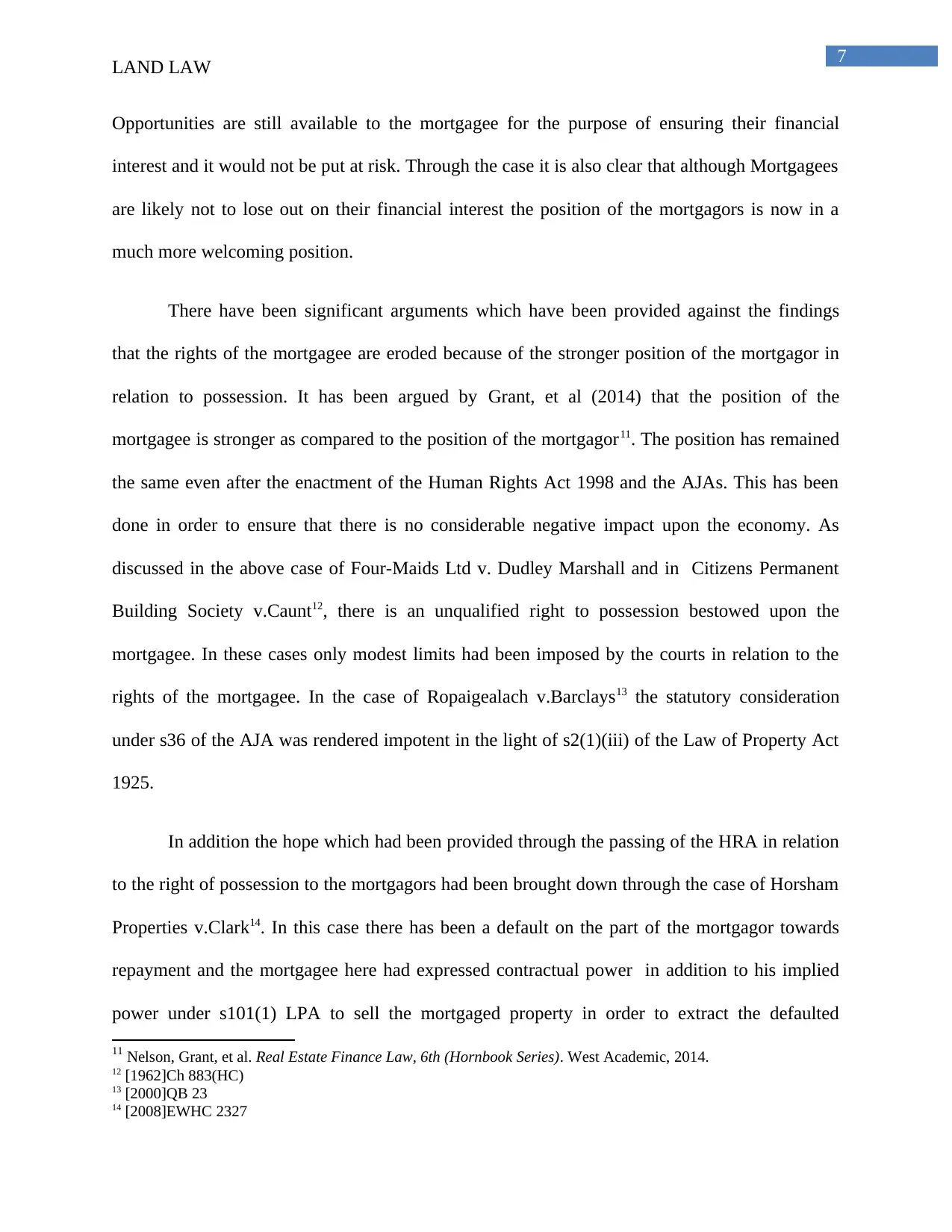
7
LAND LAW
Opportunities are still available to the mortgagee for the purpose of ensuring their financial
interest and it would not be put at risk. Through the case it is also clear that although Mortgagees
are likely not to lose out on their financial interest the position of the mortgagors is now in a
much more welcoming position.
There have been significant arguments which have been provided against the findings
that the rights of the mortgagee are eroded because of the stronger position of the mortgagor in
relation to possession. It has been argued by Grant, et al (2014) that the position of the
mortgagee is stronger as compared to the position of the mortgagor11. The position has remained
the same even after the enactment of the Human Rights Act 1998 and the AJAs. This has been
done in order to ensure that there is no considerable negative impact upon the economy. As
discussed in the above case of Four-Maids Ltd v. Dudley Marshall and in Citizens Permanent
Building Society v.Caunt12, there is an unqualified right to possession bestowed upon the
mortgagee. In these cases only modest limits had been imposed by the courts in relation to the
rights of the mortgagee. In the case of Ropaigealach v.Barclays13 the statutory consideration
under s36 of the AJA was rendered impotent in the light of s2(1)(iii) of the Law of Property Act
1925.
In addition the hope which had been provided through the passing of the HRA in relation
to the right of possession to the mortgagors had been brought down through the case of Horsham
Properties v.Clark14. In this case there has been a default on the part of the mortgagor towards
repayment and the mortgagee here had expressed contractual power in addition to his implied
power under s101(1) LPA to sell the mortgaged property in order to extract the defaulted
11 Nelson, Grant, et al. Real Estate Finance Law, 6th (Hornbook Series). West Academic, 2014.
12 [1962]Ch 883(HC)
13 [2000]QB 23
14 [2008]EWHC 2327
LAND LAW
Opportunities are still available to the mortgagee for the purpose of ensuring their financial
interest and it would not be put at risk. Through the case it is also clear that although Mortgagees
are likely not to lose out on their financial interest the position of the mortgagors is now in a
much more welcoming position.
There have been significant arguments which have been provided against the findings
that the rights of the mortgagee are eroded because of the stronger position of the mortgagor in
relation to possession. It has been argued by Grant, et al (2014) that the position of the
mortgagee is stronger as compared to the position of the mortgagor11. The position has remained
the same even after the enactment of the Human Rights Act 1998 and the AJAs. This has been
done in order to ensure that there is no considerable negative impact upon the economy. As
discussed in the above case of Four-Maids Ltd v. Dudley Marshall and in Citizens Permanent
Building Society v.Caunt12, there is an unqualified right to possession bestowed upon the
mortgagee. In these cases only modest limits had been imposed by the courts in relation to the
rights of the mortgagee. In the case of Ropaigealach v.Barclays13 the statutory consideration
under s36 of the AJA was rendered impotent in the light of s2(1)(iii) of the Law of Property Act
1925.
In addition the hope which had been provided through the passing of the HRA in relation
to the right of possession to the mortgagors had been brought down through the case of Horsham
Properties v.Clark14. In this case there has been a default on the part of the mortgagor towards
repayment and the mortgagee here had expressed contractual power in addition to his implied
power under s101(1) LPA to sell the mortgaged property in order to extract the defaulted
11 Nelson, Grant, et al. Real Estate Finance Law, 6th (Hornbook Series). West Academic, 2014.
12 [1962]Ch 883(HC)
13 [2000]QB 23
14 [2008]EWHC 2327
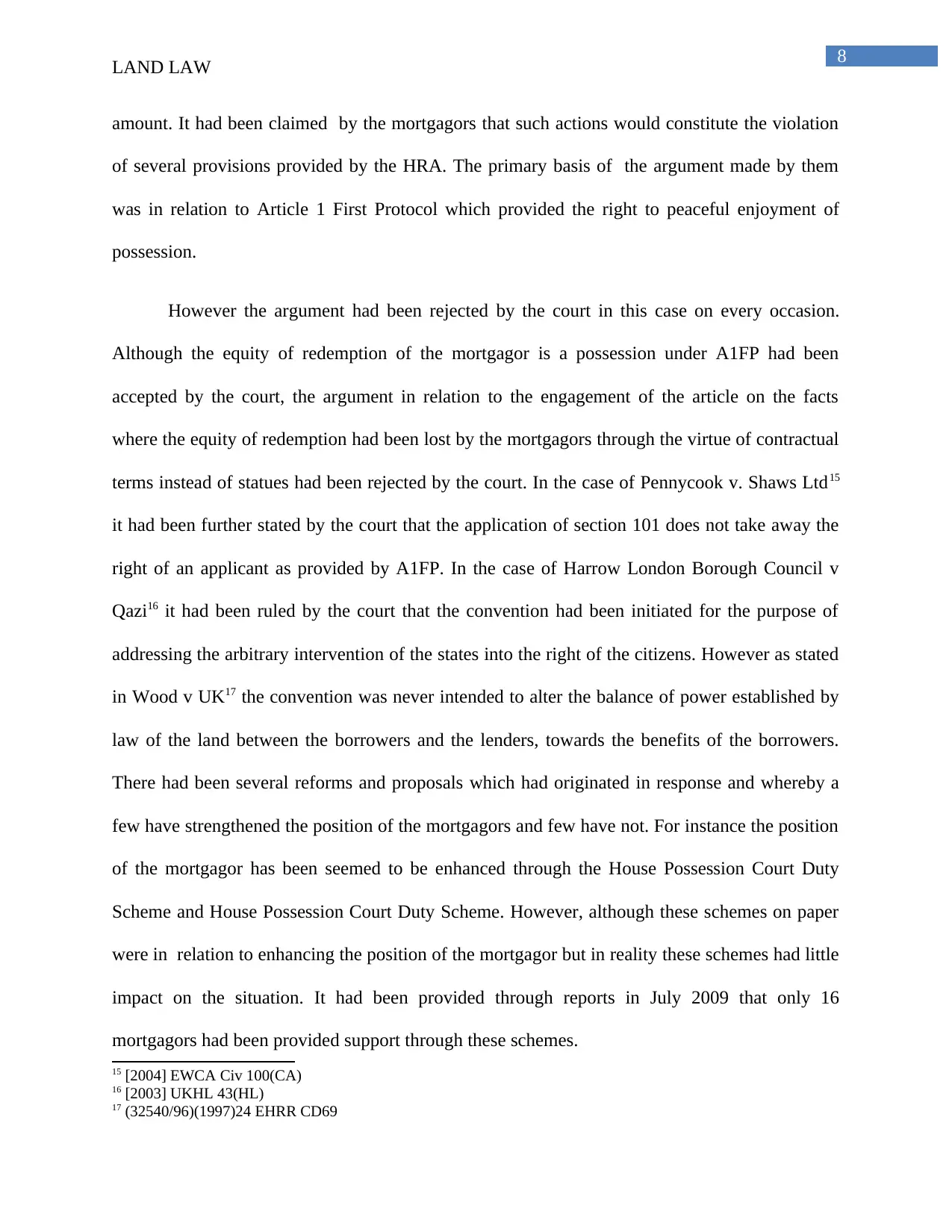
8
LAND LAW
amount. It had been claimed by the mortgagors that such actions would constitute the violation
of several provisions provided by the HRA. The primary basis of the argument made by them
was in relation to Article 1 First Protocol which provided the right to peaceful enjoyment of
possession.
However the argument had been rejected by the court in this case on every occasion.
Although the equity of redemption of the mortgagor is a possession under A1FP had been
accepted by the court, the argument in relation to the engagement of the article on the facts
where the equity of redemption had been lost by the mortgagors through the virtue of contractual
terms instead of statues had been rejected by the court. In the case of Pennycook v. Shaws Ltd15
it had been further stated by the court that the application of section 101 does not take away the
right of an applicant as provided by A1FP. In the case of Harrow London Borough Council v
Qazi16 it had been ruled by the court that the convention had been initiated for the purpose of
addressing the arbitrary intervention of the states into the right of the citizens. However as stated
in Wood v UK17 the convention was never intended to alter the balance of power established by
law of the land between the borrowers and the lenders, towards the benefits of the borrowers.
There had been several reforms and proposals which had originated in response and whereby a
few have strengthened the position of the mortgagors and few have not. For instance the position
of the mortgagor has been seemed to be enhanced through the House Possession Court Duty
Scheme and House Possession Court Duty Scheme. However, although these schemes on paper
were in relation to enhancing the position of the mortgagor but in reality these schemes had little
impact on the situation. It had been provided through reports in July 2009 that only 16
mortgagors had been provided support through these schemes.
15 [2004] EWCA Civ 100(CA)
16 [2003] UKHL 43(HL)
17 (32540/96)(1997)24 EHRR CD69
LAND LAW
amount. It had been claimed by the mortgagors that such actions would constitute the violation
of several provisions provided by the HRA. The primary basis of the argument made by them
was in relation to Article 1 First Protocol which provided the right to peaceful enjoyment of
possession.
However the argument had been rejected by the court in this case on every occasion.
Although the equity of redemption of the mortgagor is a possession under A1FP had been
accepted by the court, the argument in relation to the engagement of the article on the facts
where the equity of redemption had been lost by the mortgagors through the virtue of contractual
terms instead of statues had been rejected by the court. In the case of Pennycook v. Shaws Ltd15
it had been further stated by the court that the application of section 101 does not take away the
right of an applicant as provided by A1FP. In the case of Harrow London Borough Council v
Qazi16 it had been ruled by the court that the convention had been initiated for the purpose of
addressing the arbitrary intervention of the states into the right of the citizens. However as stated
in Wood v UK17 the convention was never intended to alter the balance of power established by
law of the land between the borrowers and the lenders, towards the benefits of the borrowers.
There had been several reforms and proposals which had originated in response and whereby a
few have strengthened the position of the mortgagors and few have not. For instance the position
of the mortgagor has been seemed to be enhanced through the House Possession Court Duty
Scheme and House Possession Court Duty Scheme. However, although these schemes on paper
were in relation to enhancing the position of the mortgagor but in reality these schemes had little
impact on the situation. It had been provided through reports in July 2009 that only 16
mortgagors had been provided support through these schemes.
15 [2004] EWCA Civ 100(CA)
16 [2003] UKHL 43(HL)
17 (32540/96)(1997)24 EHRR CD69
⊘ This is a preview!⊘
Do you want full access?
Subscribe today to unlock all pages.

Trusted by 1+ million students worldwide
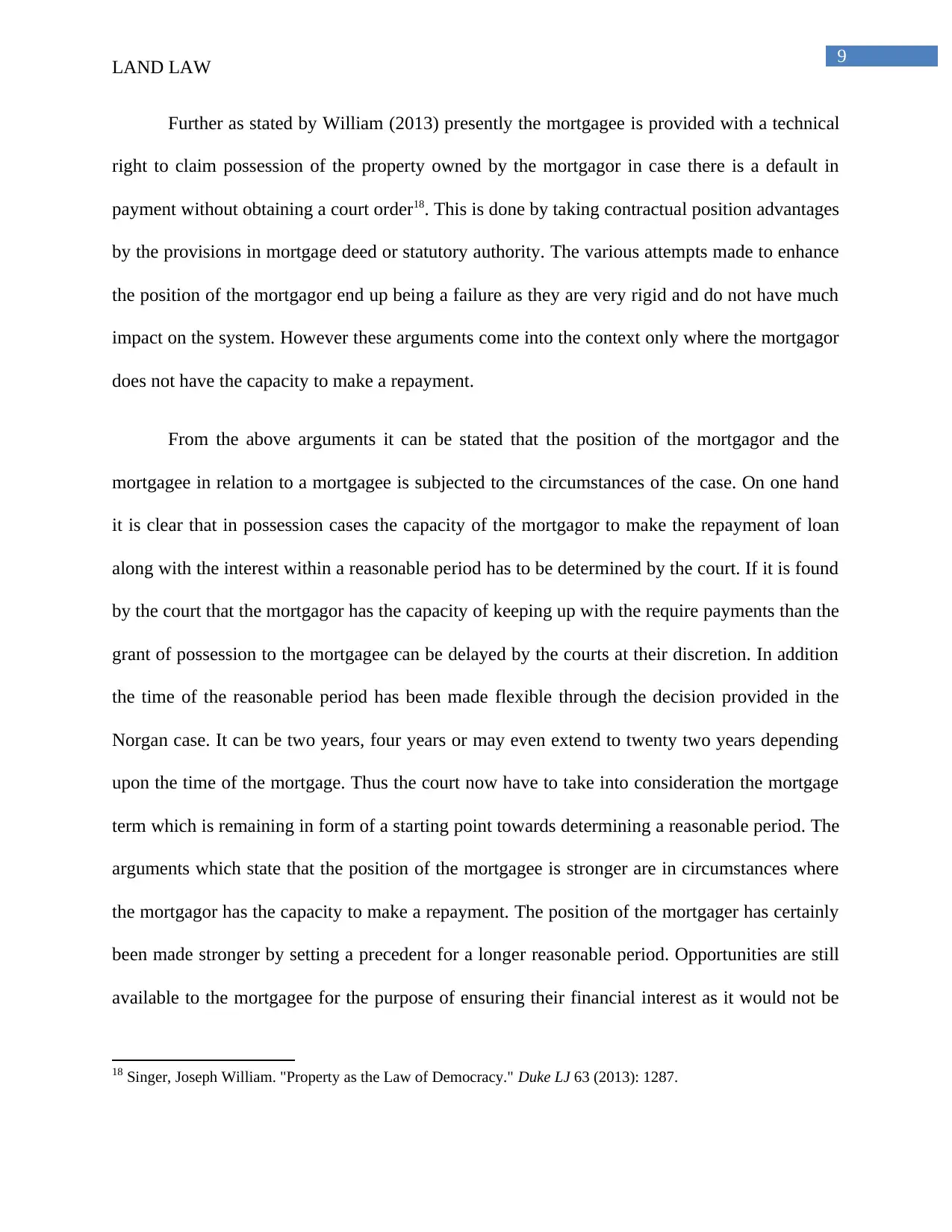
9
LAND LAW
Further as stated by William (2013) presently the mortgagee is provided with a technical
right to claim possession of the property owned by the mortgagor in case there is a default in
payment without obtaining a court order18. This is done by taking contractual position advantages
by the provisions in mortgage deed or statutory authority. The various attempts made to enhance
the position of the mortgagor end up being a failure as they are very rigid and do not have much
impact on the system. However these arguments come into the context only where the mortgagor
does not have the capacity to make a repayment.
From the above arguments it can be stated that the position of the mortgagor and the
mortgagee in relation to a mortgagee is subjected to the circumstances of the case. On one hand
it is clear that in possession cases the capacity of the mortgagor to make the repayment of loan
along with the interest within a reasonable period has to be determined by the court. If it is found
by the court that the mortgagor has the capacity of keeping up with the require payments than the
grant of possession to the mortgagee can be delayed by the courts at their discretion. In addition
the time of the reasonable period has been made flexible through the decision provided in the
Norgan case. It can be two years, four years or may even extend to twenty two years depending
upon the time of the mortgage. Thus the court now have to take into consideration the mortgage
term which is remaining in form of a starting point towards determining a reasonable period. The
arguments which state that the position of the mortgagee is stronger are in circumstances where
the mortgagor has the capacity to make a repayment. The position of the mortgager has certainly
been made stronger by setting a precedent for a longer reasonable period. Opportunities are still
available to the mortgagee for the purpose of ensuring their financial interest as it would not be
18 Singer, Joseph William. "Property as the Law of Democracy." Duke LJ 63 (2013): 1287.
LAND LAW
Further as stated by William (2013) presently the mortgagee is provided with a technical
right to claim possession of the property owned by the mortgagor in case there is a default in
payment without obtaining a court order18. This is done by taking contractual position advantages
by the provisions in mortgage deed or statutory authority. The various attempts made to enhance
the position of the mortgagor end up being a failure as they are very rigid and do not have much
impact on the system. However these arguments come into the context only where the mortgagor
does not have the capacity to make a repayment.
From the above arguments it can be stated that the position of the mortgagor and the
mortgagee in relation to a mortgagee is subjected to the circumstances of the case. On one hand
it is clear that in possession cases the capacity of the mortgagor to make the repayment of loan
along with the interest within a reasonable period has to be determined by the court. If it is found
by the court that the mortgagor has the capacity of keeping up with the require payments than the
grant of possession to the mortgagee can be delayed by the courts at their discretion. In addition
the time of the reasonable period has been made flexible through the decision provided in the
Norgan case. It can be two years, four years or may even extend to twenty two years depending
upon the time of the mortgage. Thus the court now have to take into consideration the mortgage
term which is remaining in form of a starting point towards determining a reasonable period. The
arguments which state that the position of the mortgagee is stronger are in circumstances where
the mortgagor has the capacity to make a repayment. The position of the mortgager has certainly
been made stronger by setting a precedent for a longer reasonable period. Opportunities are still
available to the mortgagee for the purpose of ensuring their financial interest as it would not be
18 Singer, Joseph William. "Property as the Law of Democracy." Duke LJ 63 (2013): 1287.
Paraphrase This Document
Need a fresh take? Get an instant paraphrase of this document with our AI Paraphraser

10
LAND LAW
put at risk. Thus through the case it is clear that although Mortgagees are likely not to lose out on
their financial interest the position of the mortgagors is now in a much more welcoming position.
LAND LAW
put at risk. Thus through the case it is clear that although Mortgagees are likely not to lose out on
their financial interest the position of the mortgagors is now in a much more welcoming position.
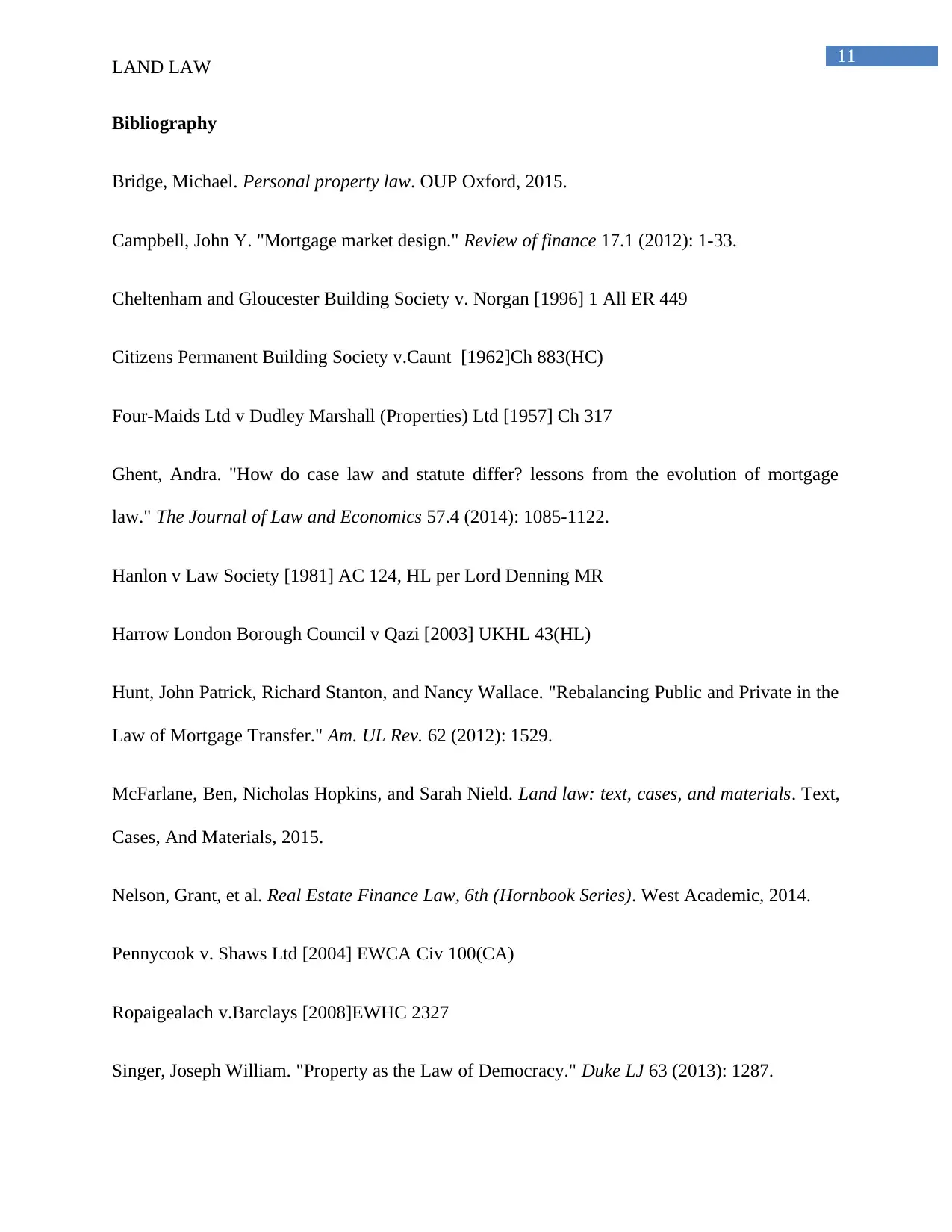
11
LAND LAW
Bibliography
Bridge, Michael. Personal property law. OUP Oxford, 2015.
Campbell, John Y. "Mortgage market design." Review of finance 17.1 (2012): 1-33.
Cheltenham and Gloucester Building Society v. Norgan [1996] 1 All ER 449
Citizens Permanent Building Society v.Caunt [1962]Ch 883(HC)
Four-Maids Ltd v Dudley Marshall (Properties) Ltd [1957] Ch 317
Ghent, Andra. "How do case law and statute differ? lessons from the evolution of mortgage
law." The Journal of Law and Economics 57.4 (2014): 1085-1122.
Hanlon v Law Society [1981] AC 124, HL per Lord Denning MR
Harrow London Borough Council v Qazi [2003] UKHL 43(HL)
Hunt, John Patrick, Richard Stanton, and Nancy Wallace. "Rebalancing Public and Private in the
Law of Mortgage Transfer." Am. UL Rev. 62 (2012): 1529.
McFarlane, Ben, Nicholas Hopkins, and Sarah Nield. Land law: text, cases, and materials. Text,
Cases, And Materials, 2015.
Nelson, Grant, et al. Real Estate Finance Law, 6th (Hornbook Series). West Academic, 2014.
Pennycook v. Shaws Ltd [2004] EWCA Civ 100(CA)
Ropaigealach v.Barclays [2008]EWHC 2327
Singer, Joseph William. "Property as the Law of Democracy." Duke LJ 63 (2013): 1287.
LAND LAW
Bibliography
Bridge, Michael. Personal property law. OUP Oxford, 2015.
Campbell, John Y. "Mortgage market design." Review of finance 17.1 (2012): 1-33.
Cheltenham and Gloucester Building Society v. Norgan [1996] 1 All ER 449
Citizens Permanent Building Society v.Caunt [1962]Ch 883(HC)
Four-Maids Ltd v Dudley Marshall (Properties) Ltd [1957] Ch 317
Ghent, Andra. "How do case law and statute differ? lessons from the evolution of mortgage
law." The Journal of Law and Economics 57.4 (2014): 1085-1122.
Hanlon v Law Society [1981] AC 124, HL per Lord Denning MR
Harrow London Borough Council v Qazi [2003] UKHL 43(HL)
Hunt, John Patrick, Richard Stanton, and Nancy Wallace. "Rebalancing Public and Private in the
Law of Mortgage Transfer." Am. UL Rev. 62 (2012): 1529.
McFarlane, Ben, Nicholas Hopkins, and Sarah Nield. Land law: text, cases, and materials. Text,
Cases, And Materials, 2015.
Nelson, Grant, et al. Real Estate Finance Law, 6th (Hornbook Series). West Academic, 2014.
Pennycook v. Shaws Ltd [2004] EWCA Civ 100(CA)
Ropaigealach v.Barclays [2008]EWHC 2327
Singer, Joseph William. "Property as the Law of Democracy." Duke LJ 63 (2013): 1287.
⊘ This is a preview!⊘
Do you want full access?
Subscribe today to unlock all pages.

Trusted by 1+ million students worldwide
1 out of 13
Related Documents
Your All-in-One AI-Powered Toolkit for Academic Success.
+13062052269
info@desklib.com
Available 24*7 on WhatsApp / Email
![[object Object]](/_next/static/media/star-bottom.7253800d.svg)
Unlock your academic potential
Copyright © 2020–2025 A2Z Services. All Rights Reserved. Developed and managed by ZUCOL.





